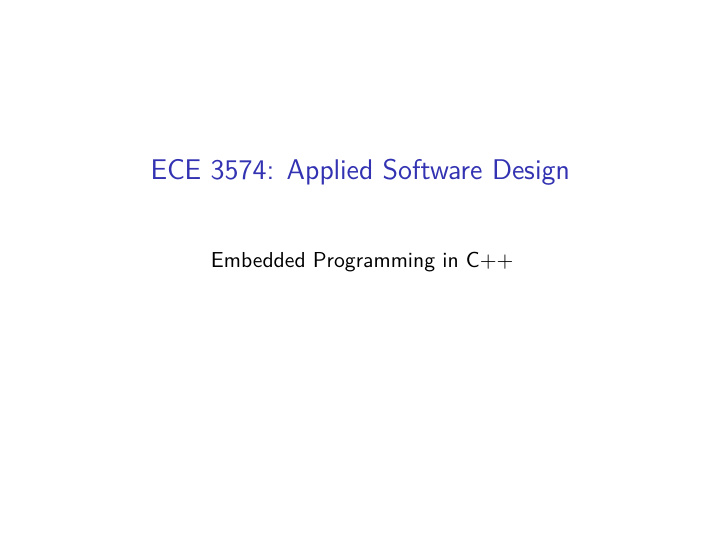



ECE 3574: Applied Software Design Embedded Programming in C++
Today we are going to look at what subset of C++ is suitable for embedded programming. ◮ What is different about embedded systems programming? ◮ C or C++? ◮ Memory Management
Some examples of embedded systems ◮ Cars ◮ Cell Phones ◮ Airplanes ◮ Space Craft ◮ Medical Equipment (e.g MRI scanners) ◮ Elevators ◮ Appliances (e.g. Washer/Dryer) ◮ Automated Assembly Systems ◮ Power Plants Typically there are several separate computers within a system, each with one or more CPUs that communicate via buses or private networks.
What is different about embedded programming? ◮ reliability is critical: failures can cost lives and millions of dollars ◮ resource limited: memory, processor cycles, power ◮ real-time response requirements: control systems have a hard update rate ◮ long-term operation: e.g satellites ◮ hands-on maintenance and software updates are difficult or not feasible
Programs in such systems need to be ◮ Correct: correct results, at the right time, in the right order with limited resources. ◮ Fault Tolerant: even including hardware failures (e.g. bad memory blocks) ◮ Have No Downtime: no-memory leaks! ◮ Predictable: hard time-constraints restrict the algorithms that can be used. ◮ Concurrent: programs work together across buses to achieve a result
Some general design guidelines ◮ Don’t leak resources: memory, locks, file descriptors ◮ Replicate: voting systems and hot-swap spares ◮ Self-check: know when your code is misbehaving ◮ Define a chain of responsibility: failure notifications should propagate ◮ Monitor: have a separate monitoring system And test, Test, TEST, TEST!, **TEST!* Emulation and virtualization can be helpful.
Example emulation setup ◮ QEMU ◮ Board: chipKIT Max32 with PIC32MX7 and bare-metal bootloader ◮ Compiler: gcc built for cross-compiling to mips (e.g. Microchip xc-g++) The standard library is not linked, instead a custom linker script is used to place the code section, entry point (main), and interrupt vector table.
C++ is predictable with three important exceptions: ◮ heap-allocation (new/delete) – placement new is ok ◮ exceptions ◮ dynamic_cast (RTTI) These language features and any libraries that use them are banned or severely restricted in most embedded systems code. Note this eliminates std::string and the standard containers library with the default allocator, but not all of the standard library.
To C or not to C So, how much of C++ does that leave? Quite a bit actually. ◮ front-end syntax (e.g. default parameter values) ◮ Classes ◮ RAII ◮ Templates ◮ can still use placement new Unfortunately, it is common to see embedded platforms that do not support C++.
Memory management Recall there are three ways to allocate memory in C++ ◮ static: linker allocates, persists as long a program runs. No concerns. ◮ stack: automatically allocated, function call depth (particularly recursive functions) is a concern ◮ dynamic (heap/pool): manually allocated by new, deallocated by delete, this has problem with predictability and pool fragmentation Dynamic memory allocation is usually either banned, or limited to startup code only. Deallocation is generally banned.
Example: using static allocation Implement a templated stack using statically allocated memory. See static_alloc.cpp
Example: using automatic allocation Implement a templated stack using automatically allocated memory. See auto_alloc.cpp
What is bad about dynamic memory allocation? Dynamic memory is allocated in a section of memory called the heap, a pool of memory allocated to the process (if an OS is used) or available to the compiler (no OS). ◮ Allocation is not really a problem as long as it does not exceed available space. ◮ Deallocation however (delete) creates holes in the memory. This can exhaust memory even without memory leaks. See process_test.cpp .
Alternatives to dynamic memory allocation The real issue with dynamic allocation is different sized objects. ◮ We could use a compacting garbage collector, but when should it run, how to make predictable? We can get predictability if we use a different data structure: ◮ stacks: pushes/pops happen at one end so object size does not matter. This mimics the way automatic allocation works. ◮ pool: allocate fixed size blocks that can be recycled without causing holes. This is an allocator for single sized objects. This is the basic idea behind custom allocators. We use specialized algorithms for allocation.
Simple stack example Consider a keypad attached to an MCU with a loop polling key presses. ◮ Each time a key is pressed it is pushed onto the stack. ◮ If a del/back key is pressed a value is pop’d from the stack. See keypad_example.cpp
Pool example Lets look at a simple implementation of a pool based allocator. See ring_buffer.h , pool.h , and pool_ex.cpp .
Next Actions and Reminders ◮ Reading on FreeRTOS
Recommend
More recommend